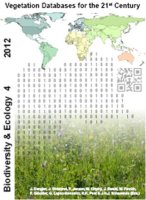Biodiversity & Ecology
Research Article Open Access
Vegetation dynamics of beech forests on limestone in central Germany over half a century – effects of climate change, forest man
Keywords: Allium ursinum; Ellenberg indicator value; Hedera helix; species composition change; spring geophyte; vegetation re-sampling.
 English
English
Abstract: The aim of this study was to investigate the vegetation dynamics of suboceanic, submontane, mesic beech forests on limestone that are very rich in spring geophytes over half a century, considering changes in abiotic and biotic conditions including global climate change. Vegetation relevés sampled in the Göttinger Wald, southern Lower Saxony, Germany, between 1955 and 1960 (n = 25) and in 1968 (n = 10) were re-surveyed in 2009 on quasi-permanent plots. Differences in species composition, species abundance and vegetation structure were compared between inventories using detrended correspondence analysis (DCA), multiple response permutation procedure (MRPP) and the Wilcoxon signed ranks test. Forty to fifty years ago, a shrub layer was scarcely present, but is common today as a consequence of intensified hunting. An increasing abundance of Allium ursinum, Urtica dioica and Sambucus nigra and a general shift to species composition with higher Ellenberg indicator values for nitrogen can be ascribed to atmospheric nitrogen deposition. The spring geophytes A. ursinum, Corydalis cava and Leucojum vernum can also benefit from global climate change with an earlier start of the vegetation period. A shift towards more oceanic conditions, with mild winters in the past fifty years, may also have increased the competitive strength of evergreen species that are susceptible to long frost periods (e.g. Hedera helix ). The re-sampling of the beech forest vegetation on limestone revealed that many factors have influenced the dynamics over the past half century. These include eutrophication and a reduction in roe deer browsing, but our results also indicate a possible influence of climate change on community composition. In focussing on a small dataset from a very rich sub-unit of beech forests on limestone, the positive response of the spring geophytes becomes particularly obvious.
Suggested citation:
Heinrichs, S., Winterhoff, W., Schmidt, W. (2012): Vegetation dynamics of beech forests on limestone in central Germany over half a century – effects of climate change, forest man. – In: Dengler, J., Oldeland, J., Jansen, F., Chytrý, M., Ewald, J., Finckh, M., Glöckler, F., Lopez-Gonzalez, G., Peet, R.K., Schaminée, J.H.J. [Eds.]: Vegetation databases for the 21st century. – Biodiversity & Ecology 4: 49–61. DOI: 10.7809/b-e.00059.


